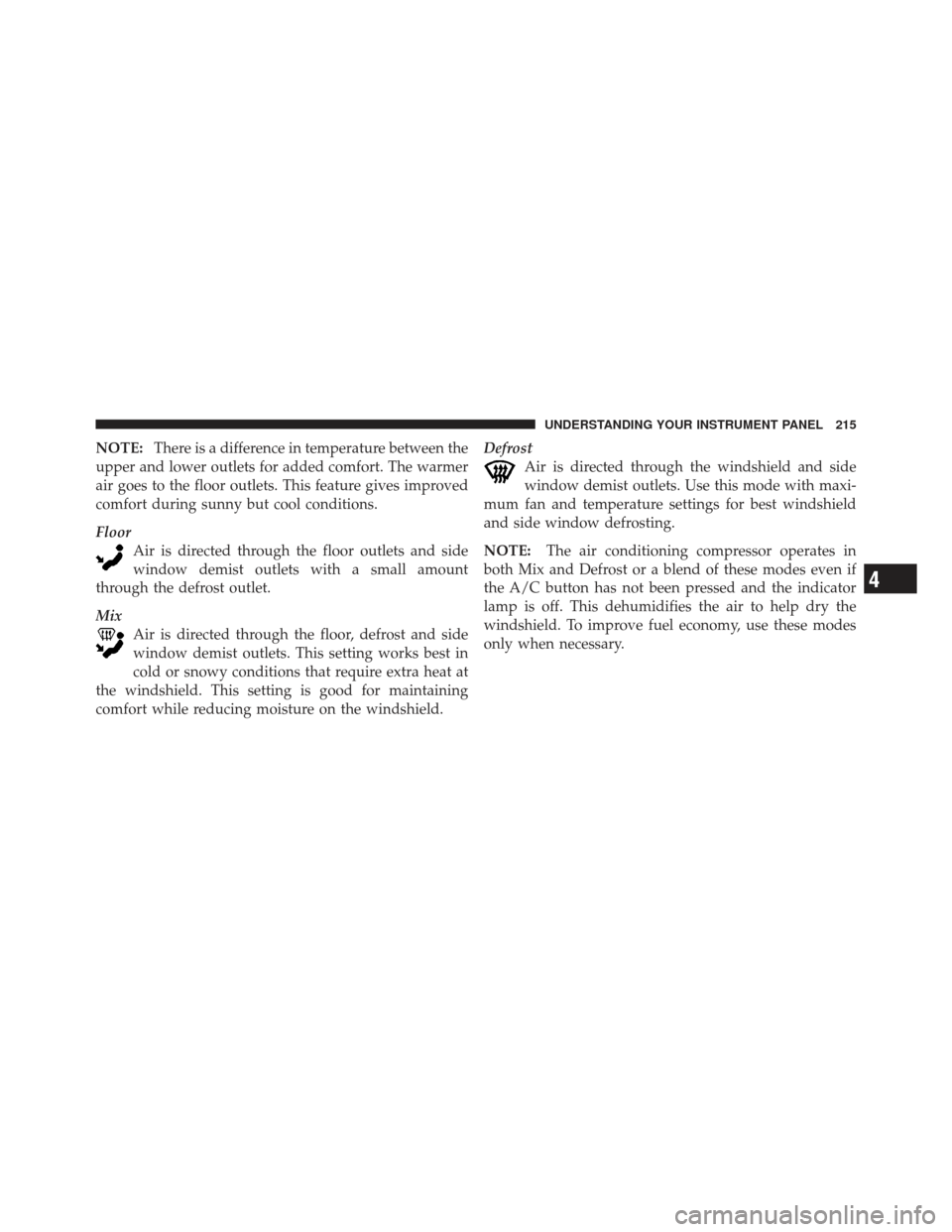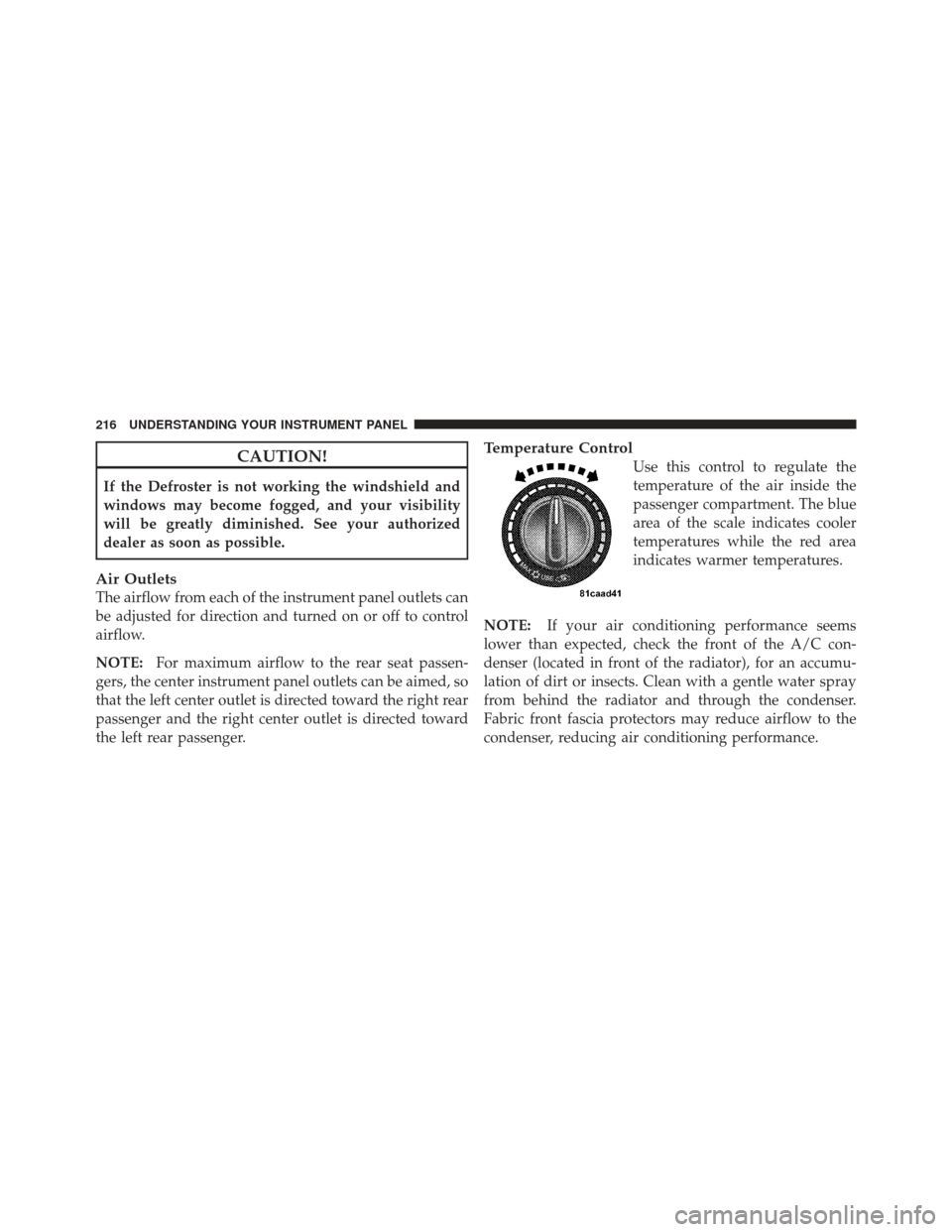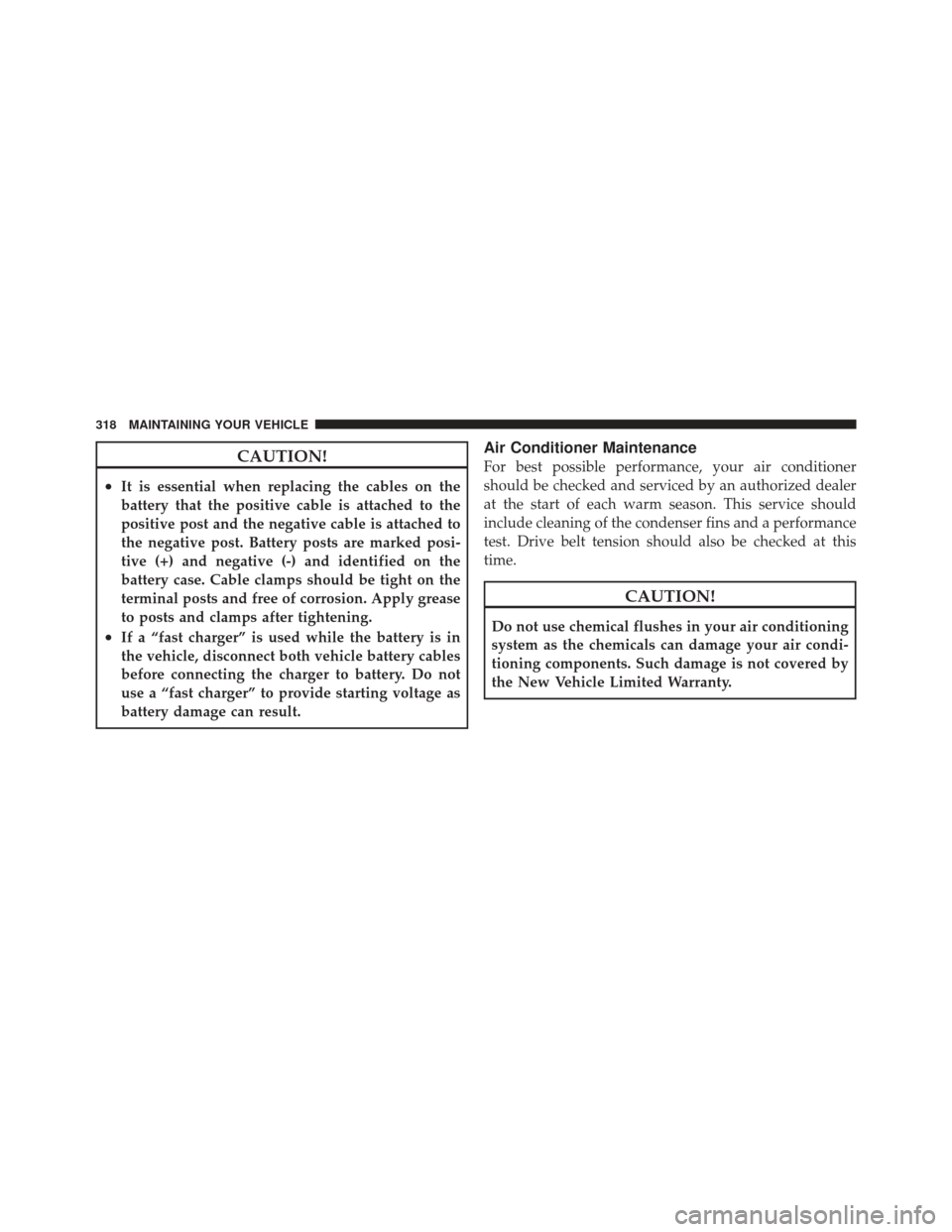Page 216 of 410

NOTE:The air conditioning system of your vehicle
contains R-134a, a refrigerant that does not deplete the
ozone layer in the upper atmosphere.
The controls are as follows:
Fan Control
Use the Fan control to regulate the
amount of air forced through the
system in any mode you select.
The fan speed increases as you
move the control to the right from
the off position.
NOTE: For vehicles equipped with Remote Start, the
climate controls will not function during Remote Start
operation if the fan control is left in the “O” (off) position.
Mode Control (Air Direction)
The Mode control allows you to
choose from several patterns of air
distribution. You can select either
a primary mode, as identified by
the symbols, or a blend of two of
these modes. The closer the con-
trol is to a particular mode, the
more air distribution you receive
from that mode
Panel Air is directed through the outlets in the instrument
panel. These outlets can be adjusted to direct airflow.
Bi-Level Air is directed through the panel and floor outlets.
214 UNDERSTANDING YOUR INSTRUMENT PANEL
Page 217 of 410

NOTE:There is a difference in temperature between the
upper and lower outlets for added comfort. The warmer
air goes to the floor outlets. This feature gives improved
comfort during sunny but cool conditions.
Floor Air is directed through the floor outlets and side
window demist outlets with a small amount
through the defrost outlet.
Mix Air is directed through the floor, defrost and side
window demist outlets. This setting works best in
cold or snowy conditions that require extra heat at
the windshield. This setting is good for maintaining
comfort while reducing moisture on the windshield. Defrost
Air is directed through the windshield and side
window demist outlets. Use this mode with maxi-
mum fan and temperature settings for best windshield
and side window defrosting.
NOTE: The air conditioning compressor operates in
both Mix and Defrost or a blend of these modes even if
the A/C button has not been pressed and the indicator
lamp is off. This dehumidifies the air to help dry the
windshield. To improve fuel economy, use these modes
only when necessary.
4
UNDERSTANDING YOUR INSTRUMENT PANEL 215
Page 218 of 410

CAUTION!
If the Defroster is not working the windshield and
windows may become fogged, and your visibility
will be greatly diminished. See your authorized
dealer as soon as possible.
Air Outlets
The airflow from each of the instrument panel outlets can
be adjusted for direction and turned on or off to control
airflow.
NOTE:For maximum airflow to the rear seat passen-
gers, the center instrument panel outlets can be aimed, so
that the left center outlet is directed toward the right rear
passenger and the right center outlet is directed toward
the left rear passenger.
Temperature Control
Use this control to regulate the
temperature of the air inside the
passenger compartment. The blue
area of the scale indicates cooler
temperatures while the red area
indicates warmer temperatures.
NOTE: If your air conditioning performance seems
lower than expected, check the front of the A/C con-
denser (located in front of the radiator), for an accumu-
lation of dirt or insects. Clean with a gentle water spray
from behind the radiator and through the condenser.
Fabric front fascia protectors may reduce airflow to the
condenser, reducing air conditioning performance.
216 UNDERSTANDING YOUR INSTRUMENT PANEL
Page 219 of 410
Air Conditioning (A/C) — If Equipped
Press the A/C button to engage
the air conditioning. A lamp will
illuminate when the air condition-
ing system is engaged
NOTE: The air conditioning compressor will not engage
until the engine has been running for about 10 seconds.
MAX A/C
To quickly cool the vehicle interior
follow the steps listed below:
1. Set the Temperature Control to Max Cool.
2. Set the Mode Control to Panel or Bi-Level.
3. Press the Recirculation button and the A/C button.
4. Adjust the Fan Control to desired airflow setting.
4
UNDERSTANDING YOUR INSTRUMENT PANEL 217
Page 292 of 410
Cooling System
To reduce potential for engine and transmission over-
heating, take the following actions:
•City Driving
When stopped for short periods of time, put transmission
in NEUTRAL but do not increase engine idle speed.
•Highway Driving
Reduce speed.
•Air Conditioning
Turn off temporarily.
RECREATIONAL TOWING (BEHIND
MOTORHOME, ETC.)
Towing — Manual Transaxle
If your vehicle is equipped with a manual transaxle, it
may be towed with all four wheels on the ground, in a
forward direction, at any legal highway speed, for any
distance, if the transaxle is in NEUTRAL.
Towing — Automatic Transaxle
CAUTION!
Recreational towing on vehicle’s equipped with a
automatic transaxle is not recommended.
NOTE: If the vehicle requires towing, make sure all four
wheels are off the ground.
290 STARTING AND OPERATING
Page 295 of 410

CAUTION!
Driving with a hot cooling system could damage
your vehicle. If the pointer of the Coolant Tempera-
ture Gage rises to the H (red) mark, the instrument
cluster will sound a chime. When safe, pull over and
stop the vehicle. Turn off the air conditioning and
wait until the pointer drops back into the normal
range. If the pointer remains on the H (red) mark for
more than a minute, turn the engine off immediately
and call for service.
NOTE: There are steps that you can take to slow down
an impending overheat condition:
•If your air conditioner (A/C) is on, turn it off. The A/C
system adds heat to the engine cooling system and
turning the A/C can help remove this heat.
•You can also turn the Temperature Control to maxi-
mum heat, the Mode Control to floor and the Fan
Control to high. This allows the heater core to act as a
supplement to the radiator and aids in removing heat
from the engine cooling system.
WARNING!
A hot engine cooling system is dangerous. You or
others could be badly burned by steam or boiling
coolant. You may want to call a service center if your
vehicle overheats. If you decide to look under the
hood yourself, refer to Section 7, Maintenance, of this
manual. Follow the warnings under the Cooling
System Pressure Cap paragraph.
6
WHAT TO DO IN EMERGENCIES 293
Page 314 of 410

MAINTENANCE PROCEDURES
The pages that follow contain therequiredmaintenance
services determined by the engineers who designed your
vehicle.
Besides the maintenance items for which there are fixed
maintenance intervals, there are other items that should
operate satisfactorily without periodic maintenance.
However, if a malfunction of these items does occur, it
could adversely affect the engine or vehicle performance.
These items should be inspected if a malfunction is
observed or suspected.CAUTION!
Your vehicle has been built with improved fluids
that protect the performance and durability of your
vehicle and also allow extended maintenance inter-
vals. Do not use chemical flushes in these compo-
nents as the chemicals can damage your engine,
transaxle, power steering or air conditioning. Such
damage is not covered by the New Vehicle Limited
Warranty. If a flush is needed because of component
malfunction, use only the specified fluid for the
flushing procedure.
Engine Oil
Checking Oil Level
To assure proper engine lubrication, the engine oil must
be maintained at the correct level. Check the oil level at
regular intervals, such as every fuel stop.
312 MAINTAINING YOUR VEHICLE
Page 320 of 410

CAUTION!
•It is essential when replacing the cables on the
battery that the positive cable is attached to the
positive post and the negative cable is attached to
the negative post. Battery posts are marked posi-
tive (+) and negative (-) and identified on the
battery case. Cable clamps should be tight on the
terminal posts and free of corrosion. Apply grease
to posts and clamps after tightening.
•If a “fast charger” is used while the battery is in
the vehicle, disconnect both vehicle battery cables
before connecting the charger to battery. Do not
use a “fast charger” to provide starting voltage as
battery damage can result.
Air Conditioner Maintenance
For best possible performance, your air conditioner
should be checked and serviced by an authorized dealer
at the start of each warm season. This service should
include cleaning of the condenser fins and a performance
test. Drive belt tension should also be checked at this
time.
CAUTION!
Do not use chemical flushes in your air conditioning
system as the chemicals can damage your air condi-
tioning components. Such damage is not covered by
the New Vehicle Limited Warranty.
318 MAINTAINING YOUR VEHICLE